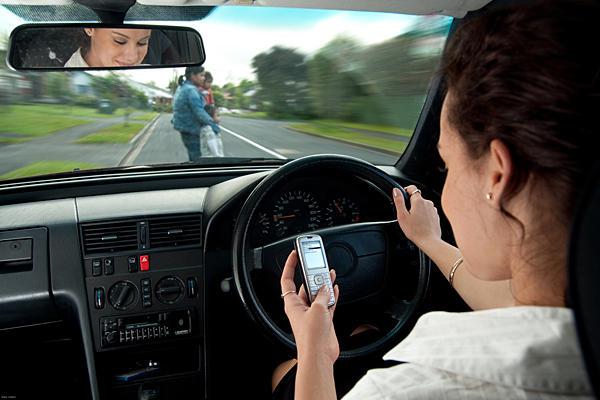

The law prohibits all drivers from using portable electronic devices, such as cell phones and smart phones, to send text messages or e-mails while driving. The penalty for a violation of this law shall be a fine of up to $150. It is a secondary law, which means in order for a person to be ticketed for the offense, the driver must have committed a primary enforcement offense such as speeding, disobeying a traffic signal or other violation. This law will replace laws passed by other jurisdictions in NYS.
(a) "Portable electronic device" shall mean any hand-held mobile telephone, as defined by subdivision one of section twelve hundred twenty-five-c of this article, personal digital assistant (PDA), handheld device with mobile data access, laptop computer, pager, broadband personal communication device, two-way messaging device, electronic game, or portable computing device.
(b) "Using" shall mean holding a portable electronic device while viewing, taking or transmitting images, playing games, or composing, sending, reading, viewing, accessing, browsing, transmitting, saving or retrieving e-mail, text messages, or other electronic data.
Driver inattention is a leading cause of traffic crashes, responsible for about 80 percent of all collisions, according to the National Highway Traffic Safety Administration. Cell phones are the #1 driver distraction, contributing to hundreds of thousands of crashes and thousands of deaths each year.
Talking on cell phones distracts our minds from driving. Beyond where our eyes and hands are while driving, it's the conversation that distracts. This is called cognitive distraction, and this is why hands-free and handheld phones have a similar crash risk – hands-free is not safer.
An estimated minimum of 28 percent of all traffic crashes – or 1.6 million per year – are caused by drivers using cell phones and texting. To protect yourself and those around you:
Distractions are the leading cause of motor vehicle crashes and the number one distraction is cell phones. The use of a cell phone while driving is a very high-risk behavior with significant impact on society because of the vast number of people engaging in the behavior and the cognitive distractions the driver experiences when engaged in a cell phone conversation. More than 50 peer-reviewed scientific studies have identified the risks associated with cell phone use while driving.
CTIA – The Wireless Association reports there are more than 270 million cell phone subscribers, this is up dramatically from 100 million subscribers in 2000. An estimated 110 billion text messages were sent monthly in 2008.
A Nationwide Insurance public opinion poll showed 81 percent of the public admitted to talking on a cell phone while driving. And NHTSA estimates that 12 percent of drivers at any point during the day are talking on cell phones while driving.
Drivers who use cell phones are four times more likely to be involved in a crash. Two different studies found this same conclusion, a 1997 New England Journal of Medicine examination of hospital records and 2005 Insurance Institute for Highway Safety study linking crashes to cell phone records.
No difference exists in the cognitive distraction (the mental process of knowing, which includes awareness, judgment and perception) between handheld and hands-free devices, according to simulator studies conducted at the Univ. of Utah.
One recent simulator study compared drivers using cell phones and drivers impaired by alcohol. Cell phone users had slower reaction times than drivers with .08 BAC and slower reaction to vehicles braking in front of them.
Many businesses and organizations understand the risk and are already taking action. Among NSC members who responded to a 2009 survey, 58 percent (1,163 out of 2,004 respondents) said their organization had a cell phone policy of some kind. Of those, 99 percent said the policy did not affect productivity and 20 percent saw decreases in employee crash rates and property damage.
A Carnegie Mellon study took pictures of the brain while drivers listened to sentences and drove on a simulator. The drivers listening to sentences had a 37 percent reduction in spatial awareness, which can directly contribute to cognitive distraction.
Talking to a passenger while driving is significantly safer than talking on a cell phone, a University of Utah study found. Passengers, unlike cell phone conversations, can make the driver aware of changing road conditions they might not see and can stop the conversation if traffic conditions warrant.